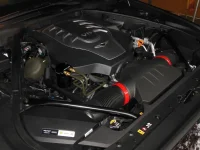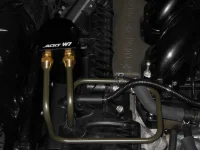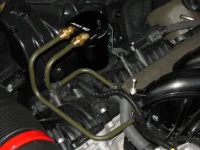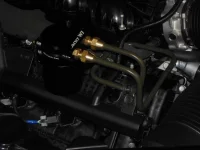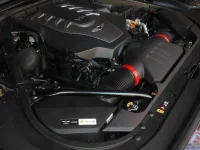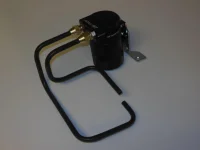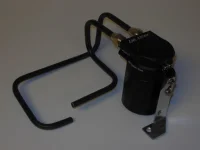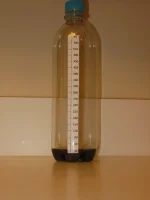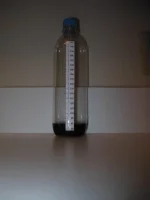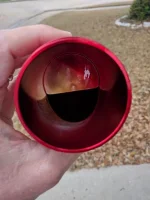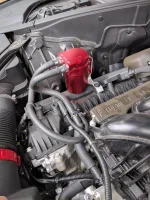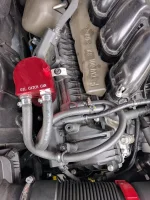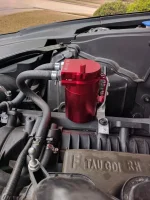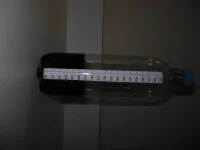mcginnpm
Registered Member
- Joined
- Jul 22, 2009
- Messages
- 424
- Reaction score
- 37
- Points
- 28
- Location
- The Low Country of South Carolina
- Genesis Model Year
- 2017
- Genesis Model Type
- Genesis G80
I recently completed installation of an ADD W1 Oil Catch Can (OCC) on my 2017 G80 5.0L and finally got around to taking some pictures of it (see attached photos).
I went for a cleaner installation using 3/8" steel tubing vice using rubber tubing. I also wanted to make it easy to swap back to OEM configuration. As you can see in the photos, all that is required to do the swap is remove two bolts and two hose clamps. The whole set-up then comes out in one piece, after which I simply re-connect the OEM PCV hose to the PCV valve.
For a mounting bracket, I bought a steel "L" corner bracket at Lowe's, bent up one leg of the "L" in a bench vice, drilled two holes for the OCC bracket, and trimmed off the excess metal with a hack saw. I bought a bolt and attached the mounting bracket to the unused bolt hole on the valve cover.
For the connectors, I bought two 3/8" threaded nut adapter fittings and two 3/8"x3/8" threaded adapter union fittings at Lowe's. You could also buy 3/8"x3/8" threaded flare x MIP adapter fittings, but the thread on the adapter going into the OCC body is male NPT whereas the hole in the OCC body itself is female NPS, so you'd have to re-tap the threading in the OCC body to female NPT standards. I just used the union fittings (which have NPS threading on both ends) with teflon tape and it worked out fine.
I also bought a 3/8" hose clamp to secure the tubing and help to stabilize the OCC.
For the tubing, I bought a PA-620 and a PA-630 3/8" steel fuel line at AutoZone which comes pre-flared. If you know how to flare steel tube and have the tools to do it, you can just buy stock 3/8" steel tubing and flare it yourself. I also got a tubing bender (free loaner at AutoZone).
I'm thinking of painting the whole contraction up in flat black, but I'll leave that for a later project.
If you've done any research on GDI engines, you know that they have issues with carbon buildup on the intake valves. The buildup comes from the "baking on" of oil vapors and mist that are routed from the PCV system back into the intake plenum. Since fuel is now injected directly into each cylinder, there is no "washing" of the intake valves from the detergents found in most fuels these days or fuel additives that you put in your fuel tank. The OCC helps to capture much of that oil before it can get to the intake plenum. I've only put about 100 miles on my OCC and it's already got about a 1/2mm layer of oil in the bottom of the can so, if I'm doing my math correctly, it has already captured about 1.3ml of oil.
I went for a cleaner installation using 3/8" steel tubing vice using rubber tubing. I also wanted to make it easy to swap back to OEM configuration. As you can see in the photos, all that is required to do the swap is remove two bolts and two hose clamps. The whole set-up then comes out in one piece, after which I simply re-connect the OEM PCV hose to the PCV valve.
For a mounting bracket, I bought a steel "L" corner bracket at Lowe's, bent up one leg of the "L" in a bench vice, drilled two holes for the OCC bracket, and trimmed off the excess metal with a hack saw. I bought a bolt and attached the mounting bracket to the unused bolt hole on the valve cover.
For the connectors, I bought two 3/8" threaded nut adapter fittings and two 3/8"x3/8" threaded adapter union fittings at Lowe's. You could also buy 3/8"x3/8" threaded flare x MIP adapter fittings, but the thread on the adapter going into the OCC body is male NPT whereas the hole in the OCC body itself is female NPS, so you'd have to re-tap the threading in the OCC body to female NPT standards. I just used the union fittings (which have NPS threading on both ends) with teflon tape and it worked out fine.
I also bought a 3/8" hose clamp to secure the tubing and help to stabilize the OCC.
For the tubing, I bought a PA-620 and a PA-630 3/8" steel fuel line at AutoZone which comes pre-flared. If you know how to flare steel tube and have the tools to do it, you can just buy stock 3/8" steel tubing and flare it yourself. I also got a tubing bender (free loaner at AutoZone).
I'm thinking of painting the whole contraction up in flat black, but I'll leave that for a later project.
If you've done any research on GDI engines, you know that they have issues with carbon buildup on the intake valves. The buildup comes from the "baking on" of oil vapors and mist that are routed from the PCV system back into the intake plenum. Since fuel is now injected directly into each cylinder, there is no "washing" of the intake valves from the detergents found in most fuels these days or fuel additives that you put in your fuel tank. The OCC helps to capture much of that oil before it can get to the intake plenum. I've only put about 100 miles on my OCC and it's already got about a 1/2mm layer of oil in the bottom of the can so, if I'm doing my math correctly, it has already captured about 1.3ml of oil.



